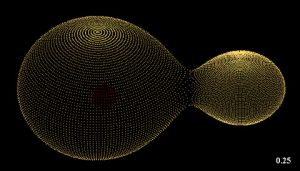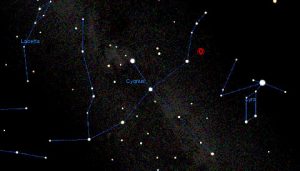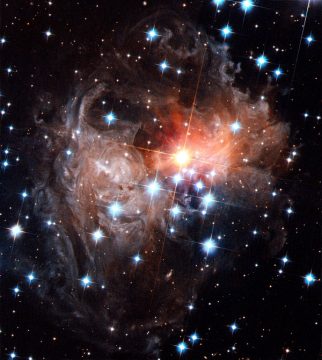Astronomers suspect that a binary star system in Cygnus is preparing to make one star of two, erupting in a red nova that will be visible to the naked eye.
If Lawrence Molnar (Calvin College) and his colleagues are correct, the two stars in the binary KIC 9832227 are about to merge.

L. Molnar / Calvin College
Stellar mergers are not a new idea. Astronomers suspect they happen in densely populated places, such as the ancient balls of stars known as globular clusters. One team also recently suggested that the famed red supergiant Betelgeuse might be the result of a merger, explaining its unusually fast spin. (The union of two stars should create a whirligigging superstar.)
Astronomers have already (probably) observed a stellar merger. In 2008, the star V1309 Scorpii revealed its existence when it suddenly flared. Follow-up work by Romuald Tylenda (Nicolaus Copernicus Astronomical Center, Poland) and colleagues, using more than 2,000 archival observations from the Optical Gravitational Lensing Experiment (OGLE), determined that V1309 Sco was likely a contact binary star. Contact binaries are stars that orbit so close together, they kiss. They can even share a common outer atmosphere, like two peanuts inside their mutual dumbbell shell.
At first, Tylenda’s team concluded, V1309 Sco’s two stars orbited each other about every 1.4 days. That period shortened exponentially with time as the stars’ outer atmospheres combined to wrap them both in a single envelope. When this happened, the object began to brighten, then faster, until the two stellar cores merged, releasing energy and dazzling observers with an outburst 10,000 times brighter than the contact binary’s original luminosity.
Molnar’s team argues that KIC 9832227 is en route to the same fate.

L. Molnar / Calvin College
This 12th-magnitude binary lies in the constellation Cygnus, with a current orbital period of about 11 hours. Back in 2013, one of Molnar’s students had discovered that the period was growing shorter; follow-up work showed the change was accelerating, as V1309 Sco’s had before its eruption. Molnar suggested in 2015 that KIC 9832227 might be heading toward a crash, but at the time his group wasn’t sure if the change was due to a distant, unseen companion star instead.
Using a variety of observations spanning 17 years, the team has now found a closer companion — which might have driven the binary into contact in the first place — but nothing farther out that could explain the apparent change in period. They also found that the period has continued to shorten, as expected if the stars are spiraling in toward each other. Although the overall change is only about 1 second, that’s notable in a field with eight decimal points of precision. Thus, lacking a solid alternative, they’re going with the imminent merger scenario.
Using V1309 Sco as a model, the astronomers predict that KIC 9832227’s duo will merge in 2022, give or take a year. Molnar announced the gutsy prediction January 6th at a press conference at the winter American Astronomical Society meeting in Dallas.

NASA / ESA / H. Bond (STScI)
Even assuming the team's explanation is the correct one, there are still several unknowns. For example, the researchers don't know when the outburst will begin. V1309 Sco started brightening nearly 2 years before its great flash, but given KIC 9832227’s characteristics, its uptick might only begin a month in advance, the team estimates.
Other binary-star astronomers are skeptical. Statistically, it's unlikely to have turned up this kind of system without trawling through a much larger number of stars, Tylenda points out. Another astronomer wondered whether the model used to predict the timing for this whole process is really dependable enough to pinpoint 2022.
KIC 9832227’s location and magnitude make it an excellent target for Northern Hemisphere amateurs. Molnar is currently working on a website where amateurs will be able to upload their observations and which will calculate how well those data match the team’s predictions. Check the team’s paper (linked to below) for coordinates and more information about the system. (Note: the binary goes under different names, depending on which catalog you’re using.)
V1309 Sco is a member of a larger category of stellar outbursts called red novae. The token example of this class is V838 Monocerotis, sighted in 2002 and known for the spectacular Hubble Space Telescope images of its light echo illuminating surrounding dust. But astronomers are hesitant to assert that mergers could explain all red novae.
References:
L. A. Molnar et al. “Prediction of a Red Nova Outburst in KIC 9832227.” Presented at the American Astronomical Society meeting, abstract 417.04.
R. Tylenda et al. “V1309 Scorpii: Merger of a Contact Binary.” Astronomy & Astrophysics, April 2011.
*Note: this blog was updated on January 10th to include additional perspectives from other researchers.
 7
7
Comments
c.dracula
January 6, 2017 at 10:54 pm
There's a documentary being made about Molnar and his team as they trace this prediction. Trailer here: http://luminous-film.com/
You must be logged in to post a comment.
Tom Hoffelder
January 9, 2017 at 2:36 pm
There is of course a bunch of really bad astronomy being presented to the public about this, in so called science websites. One says "For around six months the Boom Star will be one of the brightest in the sky before gradually dimming, returning to its normal brightness after around two to three years." That seems to describe a supernova in the Milky Way, not a red nova. Based on the predicted max mag of 2, and the light curve of the red nova in Sco, it looks like this one, IF it actually happens, will drop to 6th mag in about a month. Wherever we see this misinformation, it is our duty to try to get it corrected.
You must be logged in to post a comment.
skyboy99
January 10, 2017 at 12:02 am
Will be interesting to see what data emerges from the models (or elsewhere) regarding radiation generated and the levels of exposure expected here on Earth.
You must be logged in to post a comment.
tra06784
January 10, 2017 at 4:26 pm
Since this binary is about 1800 light years away, could the event be detected by LIGO?
You must be logged in to post a comment.
Camille M. CarlislePost Author
January 10, 2017 at 6:23 pm
Sadly no. For a merger to be detectable with LIGO -- or any other equipment that we'll have by 2022 -- it needs to involve both massive objects and a much shorter orbital period. For this star system, we’re still talking in terms of hours; LIGO is detecting inspiraling objects with periods less than a second. (http://skyandtelescope.org/astronomy-news/ligo-detects-second-black-hole-collision-06162016/) The stars in KIC 9832227 will never orbit each other that fast, even just before the merger, so they'll never accelerate enough to create detectable spacetime ripples.
You must be logged in to post a comment.
tra06784
January 10, 2017 at 7:29 pm
I was thinking that the relative distance could help mitigate the mass issue but if the binary orbital period never exceeds LIGO's threshold it clearly won't detect the event. Too bad. It would have made a very nice calibration point.
You must be logged in to post a comment.
John-Mosley
January 13, 2017 at 4:12 pm
How about giving a more common name for those of us who would like to see it with our telescopes? It's GSC 3543-1211 and I found it using SkySafari. It doesn't look like much -- just another star in the Milky Way -- but I can say I saw it "before." Its epoch 2000 coordinates are 19 29 16, +46 37 20.
You must be logged in to post a comment.
You must be logged in to post a comment.